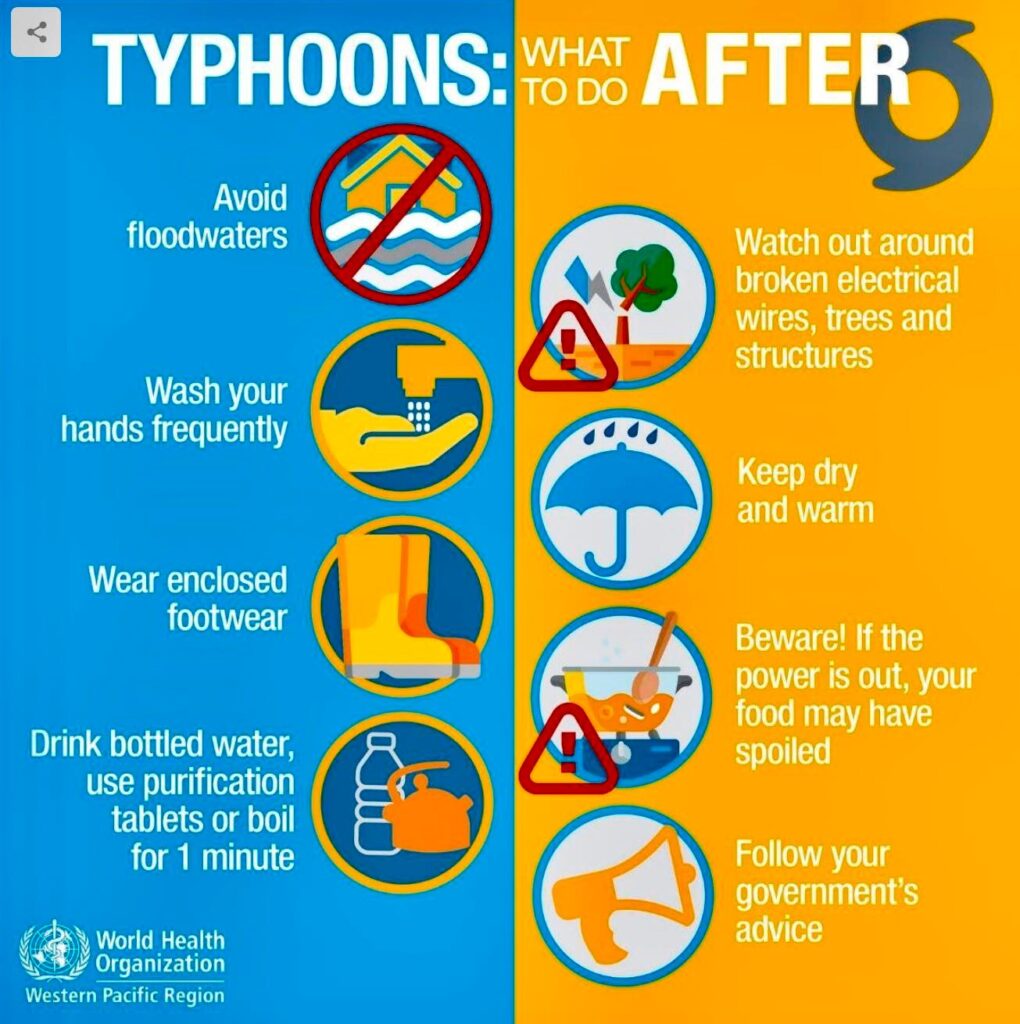Text by Henrylito D. Tacio
Photo: Wikipedia and WHO
While googling for some quotes for my feature on typhoons, I came across two thought-provoking statements from two Filipino politicians. I really don’t know if they said those words, but both seemed plausible.
Senator Manny Pacquaio, who is running for president this coming election, reportedly said: “I grew up in the Philippines, and I don’t think there is a problem with typhoons. It’s normal for us.”
He is right. “More tropical cyclones are entering the Philippine Area of Responsibility than anywhere else in the world,” admits the Philippine Atmospheric, Geophysical, and Astronomical Services Administration (PAGASA).
The Philippines has an average of 20 tropical cyclones, with about 8 or 9 of them crossing the country. The peak of the typhoon season is July through October when nearly 70% of all typhoons develop.
“We don’t get typhoons in December,” the late president Benigno Aquino III was quoted as saying. “They normally end by September. A typhoon happening in October is considered a late event.”
Unfortunately, two of the most destructive typhoons that hit the southern part of the Philippines happened in December. When Pablo (international name: Bopha) made landfall on December 4, 2012, it was a Category 5 super typhoon with winds of 280 kilometers per hour.
Pablo was considered “the strongest tropical cyclone on record to ever affect the southern island of Mindanao,” particularly Davao Oriental and Davao de Oro. Over 1,000 people were killed. Rushing floodwaters destroyed entire barangays, which made then-Interior Secretary Mar Roxas to comment: “Entire families may have been washed away.”
The other one is the most recent Odette, which hit the country on December 16. It made its first landfall in Siargao Island and left it a devastated island. “The island is now unrecognizable,” the former secretary of the Climate Change Commission, Atty. Lucille Sering told MindaNews.
Typhoons are a natural phenomenon. No one can escape from them. Since we are living in a typhoon-prone country, we need to know what to do before the typhoon enters our area, during the storm, and after the typhoon leaves.
Japan, also a typhoon-prone country, has listed some things to do before the typhoon. Japan Times shared the following tips: Make sure your phones, portable chargers, and other devices are fully charged. Bring in outdoor plants and other objects that could be blown away by heavy winds. Ensure that larger objects are secure.
If you’re in the path of a typhoon, be sure to wear clothing to bed that you can immediately go outside in. Write down important phone numbers and store them in your emergency kit. In addition to contacts of family and friends, note emergency contacts.

Before a typhoon 
After a typhoon
The website wayph.com also shares the following tips: Inspect and clean up your house, especially your drainage system. Check to see if there’s a need to fix your house, such as holes on your roofs, damaged doors, windows, or ceilings. Have them fixed as soon as possible.
Store ample amounts of ready-to-eat foods and water. Make sure that the foods and water that you will store is adequate enough for you and your family and will last for a few days. Ready-to-eat foods such as canned/packed foods are especially helpful when cooking is no longer feasible.
If you are advised to evacuate, do so. These people who will inform you of the need for evacuation are more knowledgeable than anyone else. So don’t be hard-headed, at least not during this time of distress.
Always have our emergency kits with you. Your emergency kit may include first-aid supplies, candles, flashlights, life vests, and battery-operated radio.
Money will always be an essential tool during emergencies. So, always store what you’ll only use for these kinds of situations. They can be a real life-saver.
During the storm, these are the things you need to have in mind: If there’s no advice to evacuate, then better stay inside your house. Keep yourself calm and postpone any scheduled travels. Keep on monitoring the typhoon’s movement through your television, radio, or the internet.
Stay away from downed power lines. When exposed to water, electric facilities such as power switchboards and power lines could cause not only a power outage but also the hazard of electric shock.
Do not wade along flooded areas to keep yourself from contracting water-borne diseases. If it is inevitable, wear protective gear such as raincoats and boots to protect yourself. If you are told to evacuate, calmly comply. Shut all windows, turn off the main power supply, and secure the house.
Once the typhoon is over, some things to think over: If your house was one of the heavily damaged, make sure that you heed to the advice of the authorities regarding its safety and stability. If they are uncertain of your house’s condition, do not go inside yet.
Watch out for live wires or any electrical outlet that may be submerged in water. If you don’t have sufficient knowledge of electrical wirings, have a knowledgeable person inspect these wires as well as your appliances before you actually use them again.
Boil water before drinking as it may be contaminated. Clean up: Dispose of things that may be a ground for mosquitoes to breed. Such stuff may include tires, cans, or pots.
Storms come and go. What we need to do is always to be prepared for them. It is always a tragedy after the storm: death, the devastation of edifices, and the destruction of crops. But all these should not stop from facing another day. Life goes on, as they say.
“Storms don’t come to teach us painful lessons, rather they were meant to wash us clean,” Shannon L. Alder reminded. To which Rose Fitzgerald Kennedy added: “Birds sing after a storm. Why shouldn’t we?”

